English translation
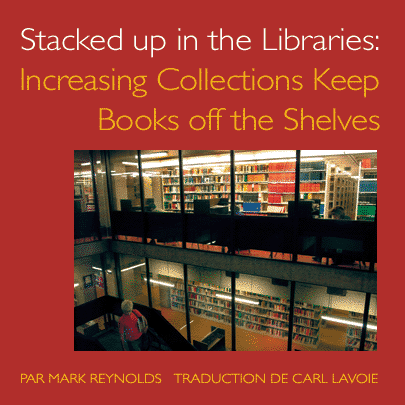
by Mark Reynolds
It's a collection as varied as it is bizarre. A stuffed falcon, complete with falconer's hood, a foam clock and, nearby, an entomology kit. The cremated remains of one of McGill's most illustrious graduates. And, of course, millions of books, maps, journals, microfilms and documents. These are the holdings of McGill's 14 libraries.
The second floor of the Redpath Library Building is where a book begins its journey from the publisher to the library stacks. The acquisitions department is where all books are ordered, delivered, processed, catalogued, and then sent to the libraries to be put on the shelves. With about 1,000 volumes going through that process every day, the department is a highly organized, if largely invisible, machine.
"It's more than out of sight, out of mind," says Joan Hobbins, BA'74, MLS'76, an ordering cataloguing services librarian. "Most people don't know we're here at all."
|
|
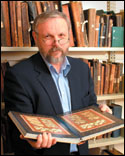 Adam Gacek,
Islamic Studies librarian. Adam Gacek,
Islamic Studies librarian.PHOTOS: Nicolas Morin |
|
|
|
That's a real problem, because with money for collections increasing ($10 million last year), the acquisitions department finds itself having to do more with about 25% fewer staff than it had a decade ago. Although donors are generous with gifts and funds for the collection, money does not come in to process them.
Even when a book is free, there are complications. Donations, although appreciated, can't always be placed on the shelves. Sometimes it's because McGill already owns a copy, and sometimes it's because it isn't appropriate for the collection. In those instances books are returned to the donor, swapped with other libraries, or donated to institutions in the developing world.
And what is appropriate can change over time. Bibliographer Suzy Slavin says that 20 years ago, no academic library would stock Reader's Digest, for example. "Ten years ago it became the subject of sociological study – who was reading it, what impact it had on society, and we were caught with our pants down. You never know what importance something is going to have in the future," she says.
All books that come into McGill -- sometimes huge freight-container loads at a time -- need to be identified within the University cataloguing system so that they can be located by topic or author and cross-referenced with other books on the subject. There is already a backlog in acquisitions of almost 20,000 volumes (many are in languages or topics that require specialized knowledge); and more can be found out on the shelves, including a number of government documents, rare books and other holdings that can be referenced with a card-cataloguing system, but are not yet entered into MUSE, the McGill Libraries' online catalogue.
"There have been no new permanent staff positions added," says Christine Oliver, so the problem persists -- and peaks every fall when Maclean's magazine publishes its rankings of Canadian universities. "Each time there is a Maclean's survey critical of the library collections, there's a push to increase them," she notes. The Students' Society, for instance, has been providing substantial funding for acquisitions in recent years.
"While it's an excellent thing that the collections budget is going up," Oliver says, "the trouble lies with the staff implications." With fewer people to process books and a rapid increase in volume, the backlog is inevitable and the staff has to perform a cataloguing triage. "The current material is the most important stuff to get done."
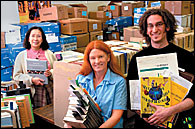 Joan Hobbins
(centre) and the catalogue order librarians Joan Hobbins
(centre) and the catalogue order librarians
|
|
|
|
|
Some of the backlog is in the Islamic Studies Library. Located in Morrice Hall, the library houses a collection of Arabic, Persian, Urdu and Indonesian works. Cataloguing them is difficult enough, but the challenges go beyond those posed by language.
Librarian Adam Gacek explains that when the Institute for Islamic Studies was founded by Wilfred Cantwell Smith in 1952, he decided that the Library of Congress subject numbers were inappropriate for the Islamic collection. The Islamic Studies Library therefore became the only one in the world to adopt the so-called "Smith system."
"It's a very unique system and may have served its purpose at the time" says Gacek, but he adds that the Smith system is not compatible with McGill's online catalogues. "Today it has become a major impediment in terms of access to information."
The fragile manuscripts with ornate hand-lettered script that are Gacek's pride have brash new competitors in the information age. Nonetheless, Joanna Andrews, MLS'72, head librarian of technical services, explains that new electronic resources are not treated any differently than ink and paper references.
"The same people are involved in selecting the electronic resources for the libraries. So the person who looks after anthropology is responsible not only for books and print journals but also for electronic resources, web journals and CD-ROMs," she says.
Like all librarians around the world, Andrews is concerned about the ephemeral nature of electronic resources. Once a website is down, it's gone for good, as is the information it contained unless a permanent record is made of it somewhere.
|
|
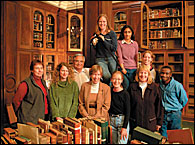 Pam Miller
(front row centre) and her team at the Osler Library. Pam Miller
(front row centre) and her team at the Osler Library.
|
|
|
|
The issue of knowledge conservation gets to the heart of librarianship. Although saddled with the image of fussy old ladies glaring over horn-rimmed glasses at noisy patrons, librarians are entrusted to be the custodians of the knowledge of humankind, a job they take very seriously. As a profession, they are forbidden to censor the works on their shelves.
It's not an abstract principle either. In 1969, reacting to civil insurrection in Quebec led by the separatist organization known as the Front de Liberation du Québec (FLQ), the provincial government banned Les Nègres Blancs d'Amérique (White Niggers of America), a controversial book by FLQ member Pierre Vallières. When the police came calling at McGill to seize it, they reached John Hobbins, BA'66, MLS'68, a young reference librarian.
"I went to see the then-director of libraries, because I didn't know what to do. I explained the situation and he said, 'I don't have time for this, look at my in-box -- it's full of letters from faculty complaining that they can never find a book in this library to which I must reply.' I walked out and suddenly realized what he was telling me. So when Sergeant Tremblay came, I said we couldn't find it."
The book ended up in the Rare Books Collection, and Hobbins is now the acting law librarian as well as the associate director of libraries at McGill. He says that the University's libraries often come under pressure to ban one book or another, but that they have a much more long-term obligation to society.
Preserving books is more than keeping them out of the hands of would-be censors. Mold, moisture and time are all the enemies of bibliophiles, as Pam Miller, BA'66, well knows. As the head of the Osler Library of the History of Medicine, Miller recently oversaw the installation of a new climate control system that will preserve the library's 55,000 volumes and other artifacts in the McIntyre Medical Building.
"We basically gutted this part of the building and started over," says Miller cheerfully.
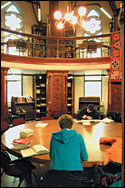 |
|
|
|
|
It was a delicate task. The Osler collection includes medieval texts, Persian clay tablets, and an urn containing the cremated remains of Osler himself, which rests in a special nook along with the desk and other relics of the famed doctor.
"This is a library, it's an archive, it's a museum and a shrine," says Miller. "(Osler) had such a remarkable personality that people have wanted to perpetuate his memory."
One of those people is Texan Dr. John McGovern, founder of the American Osler Society. With the help of his $500,000 grant, and the advice of the Canadian Conservation Institute, the library installed the new climate control system last year. All the volumes were removed from the McIntyre Building while the equipment was being put in place. The new system has created two climates within the Osler Library to cope with different preservation requirements.
Eleanor MacLean, BSc'67, MLS'69, librarian of the Blacker-Wood Library of Biology, has some special preservation challenges of her own. That library's collections include a stuffed falcon, as well as what's known as The Feather Book. At once beautiful and grotesque, this creation by a seventeenth-century Milanese gardener is 156 pages of pictures constructed entirely of bird feathers. Many of the reproductions of birds come complete with the actual skin, beaks and feet of the species represented.
Although MacLean has an obvious appreciation of the rare and odd items history has put in her care, her main job is very much in the present. MacLean, who studied biology as an undergraduate, says that it's hard maintaining a relevant collection in a field that has gone in a relatively short time from simply naming flora and fauna to examining their genetic structures.
"Trying to keep up with the basic information is an enormous challenge, both in biology and in librarianship," says MacLean, who regularly peruses the journals in the library to keep on top of current scholarship. "You have to be enough on top of it to know where to go to look for information, or to look for other resources."
Although the Blacker-Wood's 140,000 volumes are used mostly by students and faculty, MacLean receives some unusual requests from outside users as well.
"The local birdwatching community is in here quite a bit, and we had a gentleman from ICAO [International Civil Aviation Organization] come in to research the behaviour of birds that fly into jet engines and cause crashes," she recalls.
Marilyn Cohen, MLS'77, at the Education Library gets outside users as well, such as administrators and teachers from Montreal schools -- as well as a somewhat smaller clientele. "Sometimes in the summer you have three-year-olds from the McGill daycare sitting here for story hour," she says of her library's children's literature collection. Cohen's own interest is historical children's literature, which she says often mirrors the ideas and values of a particular time, and of how that world viewed young people.
For the most part, the Education Library caters to a slightly older crowd -- the students and professors of the Faculty of Education. The 101,000 volumes reflect the different teaching and research areas of the department -- educational and counselling psychology, curriculum and instruction, and second language instruction.
To provide potential teachers with the material they require, the library needs to maintain a collection of curriculum tools such as CD-ROMs and videotapes -- as well as more fun things. Poking out of the shelves at the Education Library are items like a giant foam clock, a cut-out human silhouette with stick-on organs, and a "Bug Bottle" to catch and study creepy-crawlies.
Although she stresses that the mission of her library is entirely academic, Cohen adds that there is a certain magic to the children's literature section.
"Everybody who comes in here finds a favourite book from when they were young," she says with a smile.


